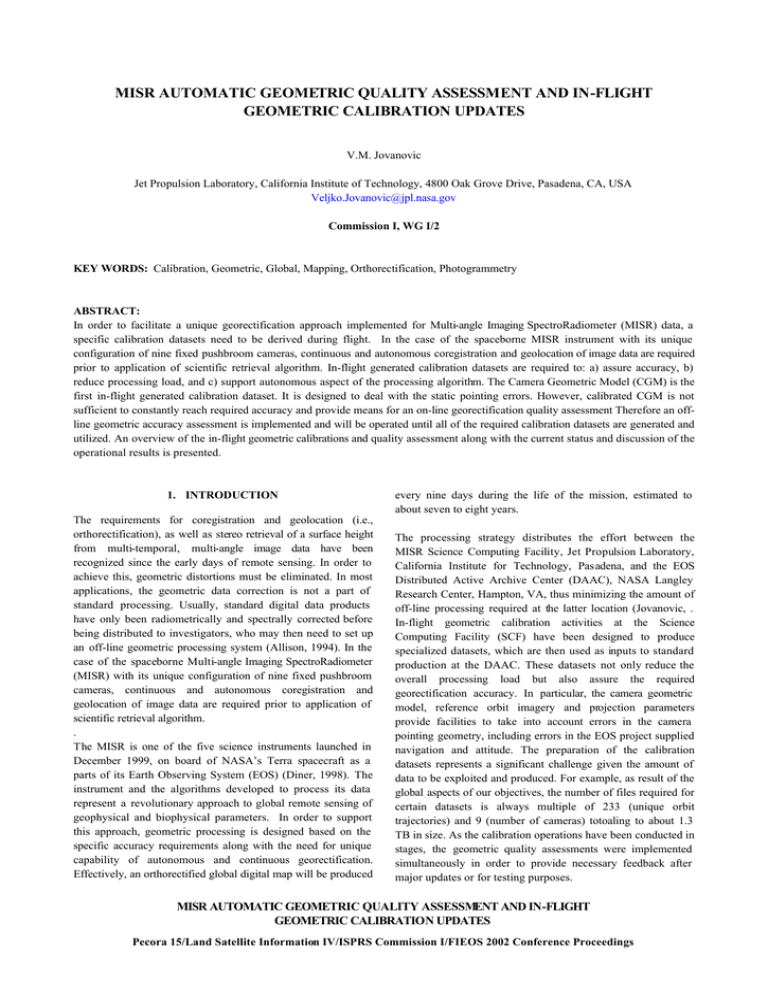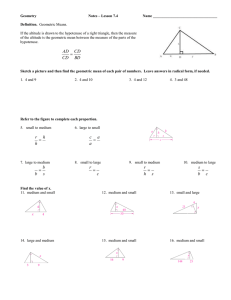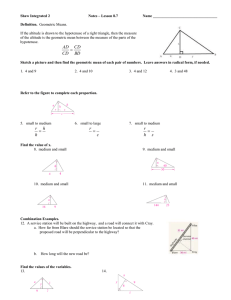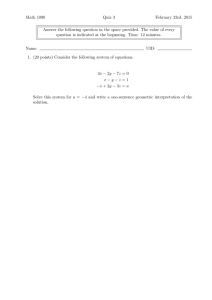MISR AUTOMATIC GEOMETRIC QUALITY ASSESSMENT AND IN-FLIGHT GEOMETRIC CALIBRATION UPDATES
advertisement

MISR AUTOMATIC GEOMETRIC QUALITY ASSESSMENT AND IN-FLIGHT GEOMETRIC CALIBRATION UPDATES V.M. Jovanovic Jet Propulsion Laboratory, California Institute of Technology, 4800 Oak Grove Drive, Pasadena, CA, USA Veljko.Jovanovic@jpl.nasa.gov Commission I, WG I/2 KEY WORDS: Calibration, Geometric, Global, Mapping, Orthorectification, Photogrammetry ABSTRACT: In order to facilitate a unique georectification approach implemented for Multi-angle Imaging SpectroRadiometer (MISR) data, a specific calibration datasets need to be derived during flight. In the case of the spaceborne MISR instrument with its unique configuration of nine fixed pushbroom cameras, continuous and autonomous coregistration and geolocation of image data are required prior to application of scientific retrieval algorithm. In-flight generated calibration datasets are required to: a) assure accuracy, b) reduce processing load, and c) support autonomous aspect of the processing algorithm. The Camera Geometric Model (CGM) is the first in-flight generated calibration dataset. It is designed to deal with the static pointing errors. However, calibrated CGM is not sufficient to constantly reach required accuracy and provide means for an on-line georectification quality assessment Therefore an offline geometric accuracy assessment is implemented and will be operated until all of the required calibration datasets are generated and utilized. An overview of the in-flight geometric calibrations and quality assessment along with the current status and discussion of the operational results is presented. 1. INTRODUCTION The requirements for coregistration and geolocation (i.e., orthorectification), as well as stereo retrieval of a surface height from multi-temporal, multi-angle image data have been recognized since the early days of remote sensing. In order to achieve this, geometric distortions must be eliminated. In most applications, the geometric data correction is not a part of standard processing. Usually, standard digital data products have only been radiometrically and spectrally corrected before being distributed to investigators, who may then need to set up an off-line geometric processing system (Allison, 1994). In the case of the spaceborne Multi-angle Imaging SpectroRadiometer (MISR) with its unique configuration of nine fixed pushbroom cameras, continuous and autonomous coregistration and geolocation of image data are required prior to application of scientific retrieval algorithm. . The MISR is one of the five science instruments launched in December 1999, on board of NASA’s Terra spacecraft as a parts of its Earth Observing System (EOS) (Diner, 1998). The instrument and the algorithms developed to process its data represent a revolutionary approach to global remote sensing of geophysical and biophysical parameters. In order to support this approach, geometric processing is designed based on the specific accuracy requirements along with the need for unique capability of autonomous and continuous georectification. Effectively, an orthorectified global digital map will be produced every nine days during the life of the mission, estimated to about seven to eight years. The processing strategy distributes the effort between the MISR Science Computing Facility, Jet Propulsion Laboratory, California Institute for Technology, Pasadena, and the EOS Distributed Active Archive Center (DAAC), NASA Langley Research Center, Hampton, VA, thus minimizing the amount of off-line processing required at the latter location (Jovanovic, . In-flight geometric calibration activities at the Science Computing Facility (SCF) have been designed to produce specialized datasets, which are then used as inputs to standard production at the DAAC. These datasets not only reduce the overall processing load but also assure the required georectification accuracy. In particular, the camera geometric model, reference orbit imagery and projection parameters provide facilities to take into account errors in the camera pointing geometry, including errors in the EOS project supplied navigation and attitude. The preparation of the calibration datasets represents a significant challenge given the amount of data to be exploited and produced. For example, as result of the global aspects of our objectives, the number of files required for certain datasets is always multiple of 233 (unique orbit trajectories) and 9 (number of cameras) totoaling to about 1.3 TB in size. As the calibration operations have been conducted in stages, the geometric quality assessments were implemented simultaneously in order to provide necessary feedback after major updates or for testing purposes. MISR AUTOMATIC GEOMETRIC QUALITY ASSESSMENT AND IN-FLIGHT GEOMETRIC CALIBRATION UPDATES Pecora 15/Land Satellite Information IV/ISPRS Commission I/FIEOS 2002 Conference Proceedings In this paper, an overview of the in-flight geometric calibrations and quality assessment along with current status and discussion of the operational results is given. In order to allow better understanding of the challenges involved and the value of the obtained results, we start with a description of the MISR imaging event from the geometric point of view. 2. MISR IMAGING EVENT view angle, ranging from 250 m in the nadir to 707 m at the most oblique angle. Sample spacing in the along- track direction is 275 m in all cameras. Each camera uses four charge-coupled device line arrays parallel in a single focal plane. The line array contains 1504 photoactive pixels, each 21 µm x 18 µm. Each line array is filtered to provide one of four MISR spectral bands. The spectral band shapes are approximately Gaussian, and centered at 446, 558, 672, and 866 nm. Due to the physical displacement of the four line arrays within the focal plane of each camera, there is an along track displacement in the Earth views at the four spectral bands (Zong, 1996). This as well as other geometric distortions have been removed during georectification within standard ground data processing (Jovanovic, 1998). 3. GEOMETRIC QUALITY ASSESSMENTS AND UPDATES 3.1 Overview Figure 1: This graphics illustrates imaging approach of MISR instrument. Nine pushbroom cameras acquire imagery continuously?during the day light portion of each orbit. The data in four spectral bands are obtained for each of nine discrete camera angles. The Terra spacecraft is in a sun-synchronous orbit, with a baseline inclination of 98.186°. The orbit period of 98.88 minutes and orbit precession rate of 0.986°/day imply a ground repeat cycle of the spacecraft nadir point of 16 days with an equatorial local crossing time of 10:30 a.m.. The orbit altitude varies from about 704 km to a maximum of 730 km. Figure 1 shows MISR nominal ground coverage during a one-day period. The instrument consists of nine push-broom cameras, with one camera pointing toward the nadir (designated An), one bank of four cameras pointing in the forward direction (designated Af, Bf, Cf, and Df in order of increasing off-nadir angle), and one bank of four cameras pointing in the aftward direction (using the same convention but designated Aa, Ba, Ca, and Da). Images are acquired with nominal view angles, relative to the surface reference ellipsoid, of 0°, 26.1°, 45.6, 60.0°, and 70.5° for An, Af/Aa, Bf/Ba, Cf/Ca, and Df/Da, respectively. The instantaneous displacement in the along-track direction between the Df and Da views is about 2800 km (see Figure 1), and it takes about 7 minutes for a ground target to be observed by all nine cameras. The cross-track instantaneous field of view and sample spacing of each pixel is 275 m for all of the off-nadir cameras, and 250 m for the nadir camera. In order to simplify manufacturing, same optical design is used for nadir and Af/Aa off-nadir cameras, resulting in slightly different cross- track instantaneous fields of view. Along-track instantaneous fields of view depend on the The science data system behind MISR data production is designed for autonomous and continuous georectification of globally acquired imagery. The ultimate use of this system is the production of orthorectified imagery within the required accuracy and simultaneous assessment of the accuracy achieved in a fully autonomous fashion. In order to achieve such us capabilities several milestones have to be reached in the following order: 1) a true static pointing knowledge of the cameras’ internal geometry and orientation of the individual cameras, relative to the spacecraft attitude frame of reference has to be established, 2) ancillary datasets designed to support georectification regarding dynamic pointing errors have to be produced and tested, and 3) statistical parameters and associated threshold which are used to describe quality of the georectification, internally during production, have to be established. To successfully reach these milestones a very large amount of data has to be acquired at the Science Computing Facilities for subsequent operations. In particular, the data received are used for a simultaneous up-to-date geometric quality assessments and in-flight geometric calibration resulting in the updates of the ancillary dataset used for standard production. Both of these operations are highly automatic, in order to deal with the optimum amount of data required until final calibration datasets and quality thresholds are established. As an illustration, MISR science data system team recently reached above listed milestones 1 and 2 by processing and analysing closed to 2TB of data. 3.2 In-flight geometric calibration The errors affecting MISR georectification and co-registration accuracy can be categorized into three groups: 1) static pointing errors, 2) dynamic pointing errors, and 3) errors associated with the topography of the projection surface. The topography errors are included with a global Digital Elevation Model (DEM) (Logan, 1999) currently in use during georectification. MISR AUTOMATIC GEOMETRIC QUALITY ASSESSMENT AND IN-FLIGHT GEOMETRIC CALIBRATION UPDATES Pecora 15/Land Satellite Information IV/ISPRS Commission I/FIEOS 2002 Conference Proceedings 2 The MISR in-flight geometric calibration is designed to take into account static and dynamic pointing errors. The calibration approach consists of two components producing two segments of the calibration dataset: 1) Camera Geometric Model (CGM), and 2) Projection Parameters (PP) and Reference Orbit Imagery (ROI). The CGM dataset is designed to deal with static pointing errors. It consists of a set of parameters used in a mathematical expression that gives the pointing direction of an arbitrary pixel to the spacecraft attitude frame of reference. These parameters represent the geometry of the camera system and account for distortions from an ideal optical system (Korechoff, 1996). Some of the parameters of the camera geometric model have been calibrated during the first eight months of the mission and later on updatwed based in the quality assements. The calibrated CGM is not sufficient to reach the required accuracy and provide a mean for on-line georectification quality assessment. This is especially true while dealing with the most oblique angles where a pointing error of 10 arcseconds will introduce a geolocation error of about 300 m. In order to routinely deal with dynamic pointing errors and facilitate automatic quality assessment, 233 pairs of PP and ROI files are being produced. A ROI file consists of cloud free MISR imagery, selected from a number of orbit passes same orbit path and mosaicked into a single image. The PP file is produced using rigorous photogrammetric methods, in order to provide accurate geolocation data for the corresponding ROI file pair. The process of creating ROI and PP pairs is similar to the regular orthorectification of time dependent imagery. A major difference is that the acquired imagery (i.e. ROI) is geolocated through PP but not resampled. A simultaneous bundle adjustment utilizing multiangle imagery and ground control information (consisting of a global Digital Elevation Model and ground control image chips) is used to model dynamic errors in the supplied spacecraft navigation data. All of the planned ROI/PP production has been completed and, at the time this manuscript is being prepared for publication, a global testing of the ROI/PP is being conducted. The final dataset will be included into standard processing, providing a global high accuracy ground truth dataset with regards to the overall georectification process. MISR radiometric product giving an estimate of the geolocation accuracy prior to orthorectification. Second type of geometric quality assessment called ”relative assessment” focuses on the coregistration of nine MISR cameras once all of the calibration datasets are utilized within georectification segment of standard processing. It is based on extraction of tie-points across orthorectified data from all nine cameras and evaluation of coregistration discrepancies relative to the nadir product. And third type of geometric quality assessment called “global assessment” is designed to check for eventual blunders in the calibration datasets. Certain MISR processing algorithms include surface stereo height retrievals with the goal of detecting cloud heights and wind vectors (Zong, 2002). These products, over clear land areas, generated with two different input configurations, are used for global testing prior to official promotion of the updated calibration dataset. A global digital elevation model (Logan, 1999) is also used in support of these assessments. In summary, three types of MISR automatic geometric quality assessment relay on the following data products. First, MISR generated products: 1) Radiometric Product, 2) Terrain corrected georectified product, 3) Stereoscopically derived surface (i.e. cloud heights) and 4) Radiometrically derived cloud mask. Second, ground truth data used for these quality assessments are the digital Ground Control Points (GCP) datasets and the Global Digital Elevation Model. And third, Terra spacecraft provided ephemeris and attitude as the output based on the TDRSS Onboard Navigation System (TONS). 4. GEOMETRIC PERFORMANCES AND CALIBRATION UPDATES The MISR instrument was launched in December 1999. On February 24, 2000, the science data processing team received the first image. Soon after an initial interactive analysis and a software fix, we started first series of geometric quality assessments and analysis. 3.3 Geometric quality assessment 4.1 Camera Geometric Model Since the beginning of the missionr a continuous acquisition of certain MISR products is required for two purposes. First, these data are used to provide an overall geometric quality assessment for the general public. And second, to provide feedback and testing source once the updates to the geometric calibration datasets are made. There are several geometric quality assement types based on the objectives as related to the status of the geometric calibration updates. A first comprehensive set of the quality assessment input data is the collection of radiometric products corresponding to 365 orbits acquired during the period of April 16 through May 11, 2000. The image chips from the GCP database were matched with the MISR imagery in order to identify differences between the true location and the one predicted by the initial Camera Geometric Model. As expected, the results indicated that there is no need for in-flight geometric calibration of the Camera Geometric Model parameters defining relative orientation of the four spectral bands within each camera. The pre-flight geometric calibration of the band-to-band orientation was accurate and it did not change after the launch. The band-to-band coregistration, within a camera in the Georectified Radiance Product, is better than 30 m (1s) across all nine cameras. First one called “absolute assessment” focuses on the total pointing error of MISR instrument prior to the georectification. It utilizes a collection of globally distributed digital Ground Control Points created from the Landsat terrain corrected data (Bailey, 1997). These GCP’s are identified within as acquired MISR AUTOMATIC GEOMETRIC QUALITY ASSESSMENT AND IN-FLIGHT GEOMETRIC CALIBRATION UPDATES Pecora 15/Land Satellite Information IV/ISPRS Commission I/FIEOS 2002 Conference Proceedings 3 At the same time, assessments regarding absolute geolocation and co-registration between nine cameras indicated definite need for in-flight geometric calibration. Important aspect of these assessments, in addition to quantifing errors, was to help decide which parameters of the Camera Geometric Model most probably needed adjustment. Even though the calibration software is capable of adjustment for all parameters at the same time, a selection of a subset is recommended in order to avoid cross-correlation effects and increase redundancy and the overall robustness of least-squares estimation. The geometric quality is visualized as the estimated geolocation errors in the along-track and across-track directions plotted in a number of different ways. For example, the plots in Figures 2a, and 2b show the geolocation errors for the Da camera. It can be seen that the overall line error (along-track) goes up to ± 4000 m for the most oblique Da cameras. In the same time line error for camera with the less oblique angle, A’s cameras, goes up to ±1000 m. The sample error (across-track) in this example is around -1000 m but it does vary in size and direction when data for all nine cameras are examined. These kinds of error plots are used to help decide which CGM parameters need to be recalibrated inflight. The plot shown in Figure 2a, which is the line error across the field of a pushbroom camera view, indicates large attitude bias in the conventional yaw direction. MISR AUTOMATIC GEOMETRIC QUALITY ASSESSMENT AND IN-FLIGHT GEOMETRIC CALIBRATION UPDATES Pecora 15/Land Satellite Information IV/ISPRS Commission I/FIEOS 2002 Conference Proceedings 4



